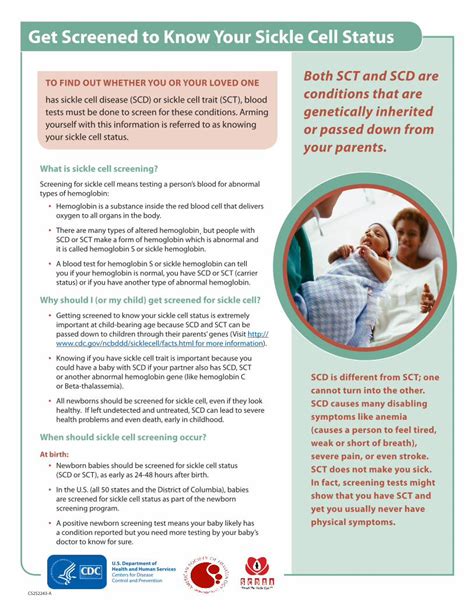Sickle cell disease, a genetic disorder that affects the hemoglobin in red blood cells, is a significant health concern worldwide. It is characterized by the production of abnormal hemoglobin, known as sickle hemoglobin or hemoglobin S, which causes red blood cells to have an irregular ‘sickle’ shape. This irregular shape disrupts the normal flow of blood, leading to a variety of serious health issues, including episodes of pain, increased risk of infections, and damage to organs such as the liver, heart, and kidneys.
Understanding one’s carrier status for sickle cell disease is crucial, particularly for individuals from high-risk populations or those with a family history of the disease. Being a carrier, also known as having the sickle cell trait, means that an individual has one normal hemoglobin gene and one sickle hemoglobin gene. Carriers typically do not display the full symptoms of sickle cell disease but can pass the sickle cell gene to their offspring.
The Importance of Sickle Cell Testing
Sickle cell testing is a straightforward process that involves a blood test to determine if an individual has sickle cell disease or is a carrier. This test can detect the presence of hemoglobin S and distinguish between individuals with sickle cell disease (HbSS), those who are carriers (HbAS), and those without the condition.
For prospective parents, knowing their carrier status is vital. If both parents are carriers of the sickle cell trait, there is a 25% chance with each pregnancy that the child will have sickle cell disease, a 50% chance that the child will be a carrier like each parent, and a 25% chance that the child will not inherit the sickle cell trait. This information can help families make informed decisions about their reproductive plans and prepare for the potential healthcare needs of their children.
How Sickle Cell Testing Works
The process of sickle cell testing typically involves the following steps:
- Blood Sample Collection: A healthcare provider will take a blood sample from the individual to be tested.
- Hemoglobin Electrophoresis: The blood sample is then analyzed using a technique called hemoglobin electrophoresis. This test separates the different types of hemoglobin in the blood based on their electrical charge, allowing for the detection of abnormal hemoglobins like hemoglobin S.
- Results Interpretation: The results of the hemoglobin electrophoresis are then interpreted by a healthcare professional. If the test detects the presence of hemoglobin S, further analysis may be needed to determine if the individual has sickle cell disease (HbSS) or is a carrier (HbAS).
Benefits of Knowing Your Carrier Status
Understanding one’s carrier status for sickle cell disease offers several benefits:
- Informed Family Planning: Knowledge of carrier status can inform decisions about family planning, allowing couples to understand the risks and consider options like genetic counseling or prenatal testing.
- Healthcare Planning: For individuals who are carriers or have the disease, knowing their status can facilitate early intervention and management of the condition, potentially reducing the risk of complications.
- Community Awareness: By encouraging testing and openness about carrier status, communities can raise awareness about sickle cell disease, reduce stigma, and promote support for affected individuals and families.
Overcoming Barriers to Sickle Cell Testing
Despite the importance of sickle cell testing, several barriers exist, including lack of awareness, access to testing, and cultural or societal stigma associated with genetic diseases. Efforts to increase awareness, improve access to genetic testing, and provide counseling can help overcome these barriers. Additionally, community-based initiatives that promote education and support can play a critical role in encouraging individuals to learn their carrier status and manage the risks associated with sickle cell disease.
Conclusion
Sickle cell testing is a powerful tool for managing and understanding sickle cell disease. By knowing their carrier status, individuals can take proactive steps in family planning, healthcare management, and contributing to community awareness and support. As medical technology continues to evolve, the hope is that more effective treatments and possibly even cures for sickle cell disease will become available. Until then, education, testing, and community support will remain at the forefront of managing this condition.
What is the difference between having sickle cell disease and being a carrier of the sickle cell trait?
+Individuals with sickle cell disease have two copies of the sickle cell gene (one from each parent), which causes the production of abnormal hemoglobin and leads to the disease's symptoms. Carriers, on the other hand, have one normal hemoglobin gene and one sickle cell gene, typically do not display the full symptoms of the disease, but can pass the sickle cell gene to their offspring.
How is sickle cell trait different from sickle cell disease in terms of health implications?
+While carriers of the sickle cell trait are generally healthier than individuals with sickle cell disease, they can still experience certain health issues, particularly under extreme conditions such as high altitudes or intense physical exertion. However, the health implications are significantly less severe than for those with sickle cell disease, who may experience recurrent episodes of pain, infections, and organ damage.
Can sickle cell disease be cured, or are there treatments available to manage its symptoms?
+Currently, there is no cure for sickle cell disease, but various treatments are available to manage its symptoms and reduce the risk of complications. These include medications to reduce pain and prevent infections, blood transfusions to increase the number of healthy red blood cells, and in some cases, bone marrow transplants. Ongoing research holds promise for future treatments and possibly a cure.
In the journey to understand and manage sickle cell disease, knowledge is power. By embracing sickle cell testing and promoting awareness, we can work towards a future where this genetic disorder is better understood, managed, and eventually, eradicated.



